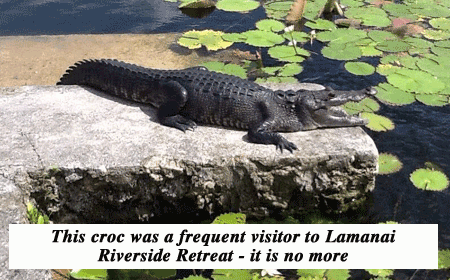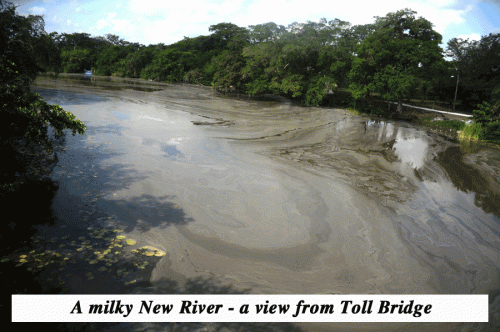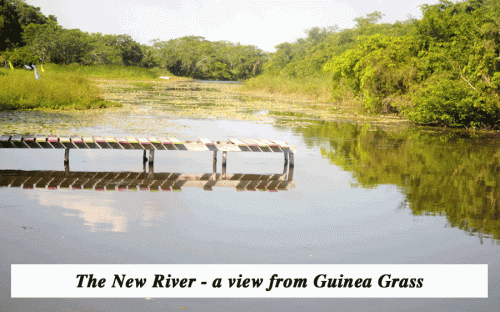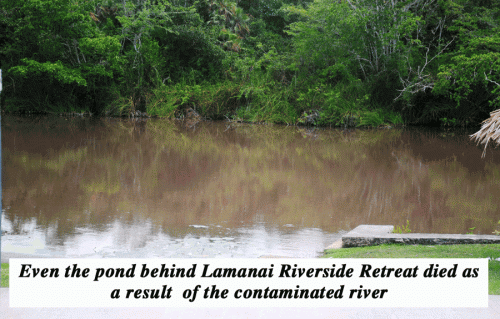“I jumped in the river and my skin started to itch me all over; it was like acid going through my pores.”
ORANGE WALK DISTRICT, Thurs. Aug. 29, 2019– In the Orange Walk District, there are two major environmental issues that pose long-term heath risks to area residents, but the Department of the Environment appears to have fallen asleep at the helm, and is not leading the charge to address these two critical issues.
The New River that has been a source of sustenance and economic activity for many Orange Walk families is dangerously polluted, and water in the New River continues to change its color, as the river seems to be struggling to stay alive.
Then in Chan Pine Ridge, soot from the BSI/ASR and more recently, from BELCOGEN (Belize Co-generation), is raining down non-stop on the village, which lies a little over a mile away, putting the lives of the almost 500 residents at serious risk.
Today, Amandala visited four areas in the Orange Walk District to get a first-hand view of the crisis that threatens to destroy the New River – Shipyard, Toll Bridge, Guinea Grass and Lamanai Riverside Retreat. At the three locations, we observed that there were no life-forms in the water; not even a ripple from fish or other aquatic life moved in the still waters, which were milky green two weeks ago, but now has taken on a rusty, brown color.
We asked Orange Walk Town resident Giovanni De La Fuente to break down how the New River has gotten to the level of pollution and what has been the level of neglect on the part of Department of the Environment.
De La Fuente explained that DOE gave Belize Sugar Industries (BSI) two permits; one of them is the hot water creek, which dumps hot water directly into the New River.
“The thing you need to understand is that whenever you put your hand into the water in the river behind BSI, the water is hot,” Del La Fuente explained.
De La Fuente went on to explain that the DOE depends on something called “voluntary compliance” in dealing with BSI.
“I don’t know how you could follow up with voluntary compliance,” De La Fuente said, “Voluntary compliance means you do it if you want to.”
We asked the DOE if they do testing themselves, but it was revealed to us that they depend on voluntary compliance. BSI does their own testing and give the results to DOE, Del La Fuente explained.
“We tested the temperature in the river ourselves, and sometimes we get 100 degrees Fahrenheit, and this has been happening for years and years,” De La Fuente revealed.
Del La Fuente said, what I want to talk about, also, is the ashes that comes out of BSI chimneys. “When these come in contact with dew water, rain or any type of water, they form what is called carbonic acid. This acid has been dropping on the population of Orange Walk for years and years, “Del La Fuente said.
Other industries have what is called scrubbers, and they scrub the ashes that come out of the chimneys, he said.
“Unfortunately for the people and residents of Chan Pine Ridge, they get the full brunt of these ashes. All their gutters and zinc is rotting, and these people have to drink this water. So this is another area where the DOE is slipping down,” De La Fuente explained.
We asked Del La Fuente for his impression of the DOE presentation last Friday.
“The DOE came here as if they were lecturing some high school children with a lot of data, and a lot of this data comes from BSI,” Del La Fuente said, “and it has not been independently verified.”
Rawell Pelayo, the owner of Lamanai Riverside Retreat, located on the bank of the New River, has lived at the same spot for 35 years.
Pelayo told Amandala that in all the years he has lived at the same spot, he has never seen the river look the way it has been looking for the past three weeks.
Pelayo said that in the past, there have been a few instances where fish would die in the river, but not on the scale that has been happening in recent times. In those times, the river would turn green, but he has never seen it clay brown like it is today.
We asked Pelayo what he thinks about the brown color that the river has turned.
Pelayo said that he spoke to someone who does testing on water, and he learned that it was a red tide of algae that has caused the water to change its color.
“About a month and a half ago, I jumped in the river and my skin started to itch me all over; it was like acid going through my pores. I had to come out and take a quick rinse-off, and I have never gone back in the water,” Pelayo said.
At Pelayo’s business place, many people are used to seeing crocodiles come up on the banks every evening before sunset.
We asked Pelayo what happened to the crocodiles that used to come up and lie on the banks.
He told us that not only the crocodiles have gone, but the birds and iguanas that used to come out every morning are all gone. We had beautiful water lilies; they are now dead, he said.
Roberto Narciso Campus, a food vendor who is also known as the “Man of the Kutchinita” (pibill), has also been an occasional fisherman on the New River.
Campus told us that he is 54 and has been dealing with the river from he was around 10 years old.
Campus said his grandfather, who was born in the area, used to fish in the river, and he grew up fishing in the river as a means to an end.
For the first time, the river has gotten in this condition, Campus said.
“I don’t have any intention of catching fish for consumption anymore in the river, because it is contaminated,” he told us.
Pedro Chan, a resident of Chan Pine Ridge, is the holder of a University of Belize Bachelor’s Degree in Natural Resource Management and is a member of the Chan Pine Ridge Environmental Committee.
Chan, 34, said he has lived all his life in the community. We asked him what has been the DOE’s response to the soot condition in his village, because he had demonstrated, in a graphic manner, the amount of soot that fell on his village. He rubbed his finger on his Ford Explorer and showed us the soot on his finger, which came off the vehicle.
“I have never seen the DOE,” Chan said, adding that he had personally written to BSI and they had invited him over to explain their plan to him.
Chan Pine Ridge is located in the Orange Walk East constituency, where the area representative is Hon. Elodio Aragon.
Chan explained that they had invited Hon. Aragon to a meeting to discuss the soot condition that is affecting their village.
“Minister Aragon never came, but he sent a representative who came to the meeting, but never really contributed. He was on his phone most of the time,” Chan said.
Chan added that the meeting was held about three months ago, and BSI asked them to wait for another 5 years until their plan kicks in.
Chan explained that BSI told them that they had invested a lot of money in the chimney and a filter.
“But that is a waste of money, because it doesn’t work,” Chan added.
We asked Chan what could be done to alleviate the soot problem in his village.
That is the question that we need DOE and the government to deal with, along with the community, he said.
Chan said DOE has never visited their village, and when they wrote to then, the replied that BSI was complying with all the requirements.
Chan said that he used to advocate by himself, but came to the realization that one voice was not enough, so three months ago, they got together and formed the Chan Pine Ridge Environmental Committee, “because we are suffering; our house is full of ashes. We have stopped collecting rain water, because it is contaminated. This is always with us, while we eat, sleep or play sports.”
Chan said that BSI has become a big company in the country and they need to be held accountable for what is happening to the residents of Chan Pine Ridge.
“We used to ride our bicycles and go fishing by the Toll Bridge, but we can’t do that anymore,” Chan lamented.





